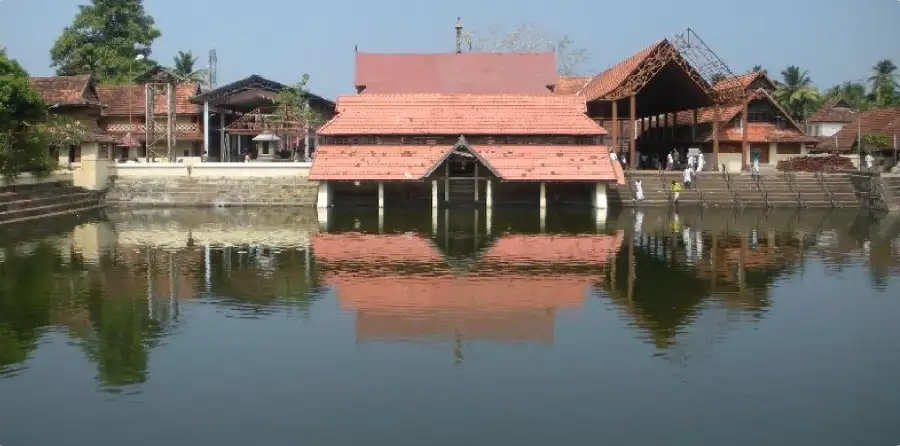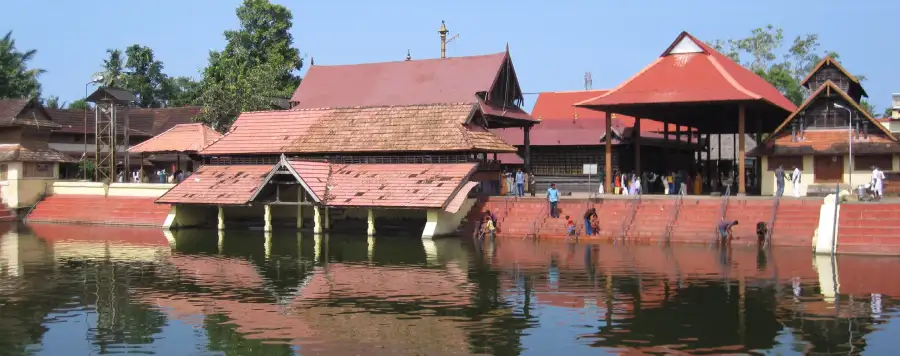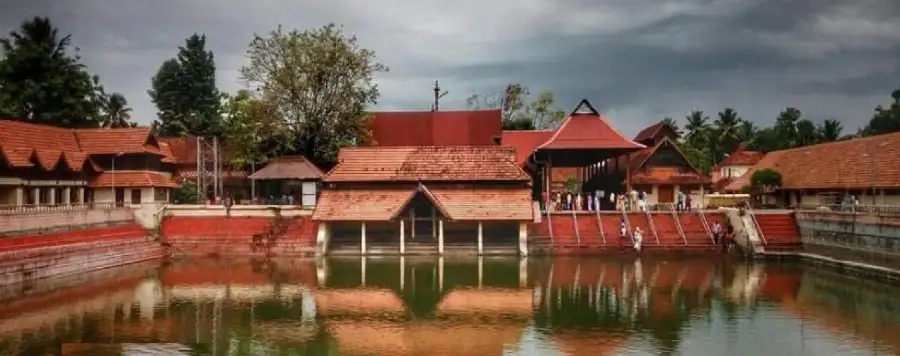
Introduction to Ambalappuzha Sree Krishna Temple
- Distance from Alappuzha railway station: 15 KM
- Distance from Alappuzha Bus stand: 16 KM
- Distance from Alappuzha Boat Jetty: 16 KM
The Ambalappuzha Sree Krishna Temple stands as a testament to the profound spirituality and architectural grandeur that defines Kerala’s rich cultural tapestry. Renowned far and wide as “Dakshina Dwarka,” or the Southern Dwarka, this temple is more than just a place of worship; it’s a pivotal landmark in the spiritual landscape of India. The moniker reflects its esteemed status among devotees, drawing parallels to the legendary Dwarka city, Lord Krishna’s abode in Gujarat. This connection underscores the temple’s deep-rooted significance in Hindu mythology and its revered place in the hearts of Krishna’s followers.

Located in the Heart of Ambalappuzha
Situated in the serene town of Ambalappuzha, within the picturesque Alappuzha District of Kerala, the temple is not just a destination for spiritual seekers but also a beacon for cultural enthusiasts and history buffs. The temple’s strategic location in the lush landscapes of Kerala adds to its allure, making it a must-visit for anyone exploring the region’s spiritual heritage. The Ambalappuzha Sree Krishna Temple, with its rich history, captivating legends, and divine ambiance, invites devotees and tourists alike to immerse themselves in a tranquil spiritual experience, amidst the backdrop of Kerala’s unparalleled natural beauty.

Historical Context of Ambalappuzha Sree Krishna Temple
The Foundation and Legacy
The Ambalappuzha Sree Krishna Temple, a cornerstone of spiritual heritage in Kerala, was established between the 15th and 17th centuries AD. This architectural marvel was the vision of Chembakasserry Pooradam Thirunal-Devanarayanan Thampuran, a ruler whose devotion to Lord Krishna led to the creation of this sacred space. The temple’s inception period marks a significant era in Kerala’s history, reflecting the region’s rich cultural and religious evolution. Its enduring legacy is a testament to the timeless devotion to Lord Krishna, attracting pilgrims and visitors from across the globe to this day.
Legends and Lore
Among the many tales that surround the Ambalappuzha Sree Krishna Temple, the legend of Lord Krishna’s chess game holds a special place. It is said that Lord Krishna, disguised as a sage, challenged the king to a game of chess, asking for grains of rice as a reward, doubling the amount on each chessboard square for every win. This seemingly modest request led to an astronomical sum, illustrating the sage’s divine nature when the king could not fulfill it. This story is not just a testament to the temple’s rich mythological roots but also symbolizes the profound wisdom and generosity associated with Lord Krishna. The legend further enriches the temple’s traditions, making the daily offering of Pal Payasam a reminder of this divine play and the temple’s deep spiritual significance.

Architectural Marvels of Ambalappuzha Temple
Kerala’s Architectural Splendor
The Ambalappuzha Sree Krishna Temple is a masterpiece that showcases the exquisite Kerala style of architecture, renowned for its harmony with nature and intricate craftsmanship. Constructed using traditional materials like wood, laterite, and stone, the temple stands as a testament to the architectural ingenuity of ancient Kerala. Its layout is a thoughtful representation of the cosmic structure, embodying spiritual symbolism in every corner. The temple’s gabled roofs, wooden carvings, and majestic pillars not only enhance its aesthetic appeal but also serve as a medium for storytelling, depicting various episodes from Hindu mythology. This architectural splendor provides a serene and divine ambiance, inviting devotees to immerse themselves in contemplation and worship.
Iconography and Art
Within the sacred walls of the Ambalappuzha Sree Krishna Temple lies a treasure trove of art and iconography. The temple is particularly celebrated for its vibrant murals and paintings that illustrate the ten avatars of Lord Vishnu, known as Dasavatharam. These artistic depictions are not merely decorative elements but are imbued with deep religious significance, each avatar symbolizing a different aspect of divinity and moral values. The craftsmanship displayed in these artworks reflects the artists’ devotion and meticulous attention to detail, making the temple a focal point for cultural and spiritual enrichment. The iconography of Ambalappuzha enriches the devotees’ experience, offering insights into the profound narratives of Hinduism and the omnipresence of Lord Vishnu.

Spiritual Practices and Rituals at Ambalappuzha Sree Krishna Temple
Daily Offerings and Significance
At the heart of the Ambalappuzha Sree Krishna Temple’s daily rituals is the divine offering of Pal Payasam, a sweet milk pudding that holds a cherished place in the temple’s spiritual practices. This offering is not just a culinary delight but carries a profound mythological significance, rooted in the legend of Lord Krishna’s clever victory in a game of chess. The story symbolizes the infinite generosity and wisdom of the deity, promising to fulfill a seemingly modest request that unfolds into an endless bounty. Prepared daily with devotion, the Pal Payasam is served to devotees, embodying the temple’s enduring hospitality and the grace of Lord Krishna. This ritual nurtures a deep spiritual connection between the devotees and the divine, making it a pivotal aspect of the temple’s daily worship.
Festivals and Celebrations
The Ambalappuzha Sree Krishna Temple is the epicenter of vibrant festivals and celebrations, each marking significant moments in the Hindu calendar and the life of Lord Krishna. The Ambalappuzha Temple Festival is a spectacular event that draws devotees from far and wide, celebrated with traditional music, dance, and elaborate processions. This festival commemorates the installation of the temple’s idol, embodying the community’s collective devotion and joy.
The Aaraattu festival, another cornerstone of the temple’s spiritual calendar, is marked by a ceremonial bath of the deity’s idol in the holy waters, symbolizing purification and renewal. This event is accompanied by rituals, music, and the shared anticipation of blessings among the gathered faithful.
Pallipana, performed once every twelve years, is a unique ritual involving sorcerers and elaborate ceremonies, showcasing the temple’s deep mystical traditions. These festivals and celebrations are not just cultural spectacles but are deeply imbued with religious significance, offering devotees a path to immerse themselves in devotion and experience the divine grace of Lord Krishna.

The Cultural Tapestry of Ambalappuzha
Daily Offerings and Significance
Ambalappuzha Sree Krishna Temple is not just a spiritual haven; it’s also the cradle of Ottanthullal, a unique performing art form that blends satire with dance and music. This art form, which originated within the temple’s hallowed grounds, was created by the legendary poet Kunchan Nambiar in the 18th century. Ottanthullal is distinguished by its sharp socio-political commentary, delivered through rhythmic movements and poetic verses. It serves as a mirror to society, reflecting the social injustices and political issues of the time. The temple, by fostering Ottanthullal, has contributed significantly to Kerala’s cultural landscape, ensuring that this critical art form continues to engage and enlighten future generations.
Art and Devotion
The Ambalappuzha Sree Krishna Temple stands as a beacon of art and devotion, intertwining religious practices with the promotion of Kerala’s rich traditional art forms. Beyond its spiritual rituals, the temple acts as a vibrant cultural hub, where music, dance, and visual arts flourish under the banner of devotion. This fusion of art and spirituality not only enriches the community’s cultural life but also strengthens the bond between the devotees and the divine. The temple’s role in nurturing these art forms has made it a pivotal institution in Kerala, where the echoes of devotion are harmonized with the rhythms of traditional artistry. Through its support of the arts, the temple ensures that the essence of Kerala’s heritage is preserved and celebrated, fostering a sense of unity and pride within the community.
Visiting Ambalappuzha Sree Krishna Temple
Planning Your Visit
Temple Timings: Open daily from 5:00 AM to 12:00 PM and 5:00 PM to 8:00 PM. Special rituals may alter these times, so checking ahead is advisable.
Best Times to Visit: The ideal time to visit is during the cooler months from October to March, when Kerala’s climate is most pleasant. Additionally, visiting during the Ambalappuzha Temple Festival (usually in March or April) offers a unique cultural experience.
What to Expect: Expect a serene atmosphere conducive to meditation and prayer. Dress modestly as a sign of respect, and be prepared to remove your shoes before entering the temple premises.
How to Reach
By Air: The nearest airport is Cochin International Airport, about 85 km away. From there, you can hire a taxi or take a bus to Ambalappuzha.
Best Times to Visit: The ideal time to visit is during the cooler months from October to March, when Kerala’s climate is most pleasant. Additionally, visiting during the Ambalappuzha Temple Festival (usually in March or April) offers a unique cultural experience.
What to Expect: Expect a serene atmosphere conducive to meditation and prayer. Dress modestly as a sign of respect, and be prepared to remove your shoes before entering the temple premises.
Accommodations and Facilities
Budget Options: Several budget-friendly guesthouses and lodges are available in Ambalappuzha town, offering basic amenities for a comfortable stay.
Mid-Range to Luxury: For those seeking more comfort, a range of mid-range to luxury hotels is available in Alappuzha (Alleppey), about 14 km from the temple. Many of these offer traditional Kerala cuisine and Ayurvedic treatments.
Facilities: The temple area is equipped with basic facilities like drinking water and restrooms. Shops selling religious artifacts and local snacks can be found nearby.
Conclusion
The Ambalappuzha Sree Krishna Temple, with its deep-rooted history and divine ambiance, stands as a beacon of spirituality and cultural heritage in Kerala. This sacred site, often referred to as the “Dakshina Dwarka,” mirrors the spiritual essence and architectural grandeur of its northern counterpart, offering a serene sanctuary for devotees and a captivating sight for tourists. Its enduring significance in Kerala’s spiritual landscape is a testament to the timeless devotion to Lord Krishna, whose legends and teachings permeate the very fabric of this holy place.
The temple’s unique blend of mythological lore, traditional art forms, and vibrant festivals enriches the cultural tapestry of Kerala, making it a pivotal destination for those seeking spiritual solace and cultural exploration. The daily rituals, especially the offering of the famed Pal Payasam, symbolize the temple’s ongoing commitment to upholding the values of generosity, devotion, and community spirit.
For devotees, Ambalappuzha Sree Krishna Temple is a site of unparalleled spiritual significance, a place where faith and tradition converge in the worship of Lord Krishna. For tourists, it offers a glimpse into Kerala’s rich religious traditions and the opportunity to experience the peacefulness and beauty of this sacred space. The temple’s legacy, characterized by its spiritual depth, architectural beauty, and cultural vitality, continues to inspire and attract visitors from around the world, securing its place as a cherished landmark in India’s spiritual and cultural landscape.